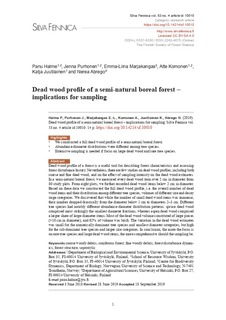| dc.description.abstract | Dead wood profile of a forest is a useful tool for describing forest characteristics and assessing forest disturbance history. Nevertheless, there are few studies on dead wood profiles, including both coarse and fine dead wood, and on the effect of sampling intensity on the dead wood estimates. In a semi-natural boreal forest, we measured every dead wood item over 2 cm in diameter from 80 study plots. From eight plots, we further recorded dead wood items below 2 cm in diameter. Based on these data we constructed the full dead wood profile, i.e. the overall number of dead wood items and their distribution among different tree species, volumes of different size and decay stage categories. We discovered that while the number of small dead wood items was immense, their number dropped drastically from the diameter below 1 cm to diameters 2–3 cm. Different tree species had notably different abundance-diameter distribution patterns: spruce dead wood comprised most strikingly the smallest diameter fractions, whereas aspen dead wood comprised a larger share of large-diameter items. Most of the dead wood volume constituted of large pieces (>10 cm in diameter), and 62% of volume was birch. The variation in the dead wood estimates was small for the numerically dominant tree species and smallest diameter categories, but high for the sub-dominant tree species and larger size categories. In conclusion, the more the focus is on rare tree species and large dead wood items, the more comprehensive should the sampling be. | nb_NO |

